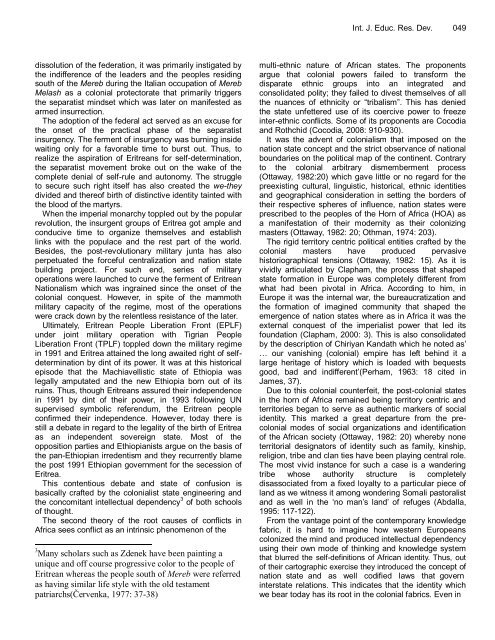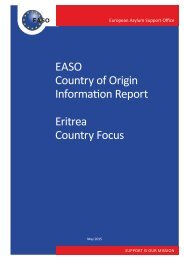o94lwpv
o94lwpv
o94lwpv
You also want an ePaper? Increase the reach of your titles
YUMPU automatically turns print PDFs into web optimized ePapers that Google loves.
Int. J. Educ. Res. Dev. 049<br />
dissolution of the federation, it was primarily instigated by<br />
the indifference of the leaders and the peoples residing<br />
south of the Mereb during the Italian occupation of Mereb<br />
Melash as a colonial protectorate that primarily triggers<br />
the separatist mindset which was later on manifested as<br />
armed insurrection.<br />
The adoption of the federal act served as an excuse for<br />
the onset of the practical phase of the separatist<br />
insurgency. The ferment of insurgency was burning inside<br />
waiting only for a favorable time to burst out. Thus, to<br />
realize the aspiration of Eritreans for self-determination,<br />
the separatist movement broke out on the wake of the<br />
complete denial of self-rule and autonomy. The struggle<br />
to secure such right itself has also created the we-they<br />
divided and thereof birth of distinctive identity tainted with<br />
the blood of the martyrs.<br />
When the imperial monarchy toppled out by the popular<br />
revolution, the insurgent groups of Eritrea got ample and<br />
conducive time to organize themselves and establish<br />
links with the populace and the rest part of the world.<br />
Besides, the post-revolutionary military junta has also<br />
perpetuated the forceful centralization and nation state<br />
building project. For such end, series of military<br />
operations were launched to curve the ferment of Eritrean<br />
Nationalism which was ingrained since the onset of the<br />
colonial conquest. However, in spite of the mammoth<br />
military capacity of the regime, most of the operations<br />
were crack down by the relentless resistance of the later.<br />
Ultimately, Eritrean People Liberation Front (EPLF)<br />
under joint military operation with Tigrian People<br />
Liberation Front (TPLF) toppled down the military regime<br />
in 1991 and Eritrea attained the long awaited right of selfdetermination<br />
by dint of its power. It was at this historical<br />
episode that the Machiavellistic state of Ethiopia was<br />
legally amputated and the new Ethiopia born out of its<br />
ruins. Thus, though Eritreans assured their independence<br />
in 1991 by dint of their power, in 1993 following UN<br />
supervised symbolic referendum, the Eritrean people<br />
confirmed their independence. However, today there is<br />
still a debate in regard to the legality of the birth of Eritrea<br />
as an independent sovereign state. Most of the<br />
opposition parties and Ethiopianists argue on the basis of<br />
the pan-Ethiopian irredentism and they recurrently blame<br />
the post 1991 Ethiopian government for the secession of<br />
Eritrea.<br />
This contentious debate and state of confusion is<br />
basically crafted by the colonialist state engineering and<br />
the concomitant intellectual dependency 3 of both schools<br />
of thought.<br />
The second theory of the root causes of conflicts in<br />
Africa sees conflict as an intrinsic phenomenon of the<br />
3 Many scholars such as Zdenek have been painting a<br />
unique and off course progressive color to the people of<br />
Eritrean whereas the people south of Mereb were referred<br />
as having similar life style with the old testament<br />
patriarchs(Červenka, 1977: 37-38)<br />
multi-ethnic nature of African states. The proponents<br />
argue that colonial powers failed to transform the<br />
disparate ethnic groups into an integrated and<br />
consolidated polity; they failed to divest themselves of all<br />
the nuances of ethnicity or “tribalism”. This has denied<br />
the state unfettered use of its coercive power to freeze<br />
inter-ethnic conflicts. Some of its proponents are Cocodia<br />
and Rothchid (Cocodia, 2008: 910-930).<br />
It was the advent of colonialism that imposed on the<br />
nation state concept and the strict observance of national<br />
boundaries on the political map of the continent. Contrary<br />
to the colonial arbitrary dismemberment process<br />
(Ottaway, 1982:20) which gave little or no regard for the<br />
preexisting cultural, linguistic, historical, ethnic identities<br />
and geographical consideration in setting the borders of<br />
their respective spheres of influence, nation states were<br />
prescribed to the peoples of the Horn of Africa (HOA) as<br />
a manifestation of their modernity as their colonizing<br />
masters (Ottaway, 1982: 20; Othman, 1974: 203).<br />
The rigid territory centric political entities crafted by the<br />
colonial masters have produced pervasive<br />
historiographical tensions (Ottaway, 1982: 15). As it is<br />
vividly articulated by Clapham, the process that shaped<br />
state formation in Europe was completely different from<br />
what had been pivotal in Africa. According to him, in<br />
Europe it was the internal war, the bureaucratization and<br />
the formation of imagined community that shaped the<br />
emergence of nation states where as in Africa it was the<br />
external conquest of the imperialist power that led its<br />
foundation (Clapham, 2000: 3). This is also consolidated<br />
by the description of Chiriyan Kandath which he noted as‟<br />
… our vanishing (colonial) empire has left behind it a<br />
large heritage of history which is loaded with bequests<br />
good, bad and indifferent‟(Perham, 1963: 18 cited in<br />
James, 37).<br />
Due to this colonial counterfeit, the post-colonial states<br />
in the horn of Africa remained being territory centric and<br />
territories began to serve as authentic markers of social<br />
identity. This marked a great departure from the precolonial<br />
modes of social organizations and identification<br />
of the African society (Ottaway, 1982: 20) whereby none<br />
territorial designators of identity such as family, kinship,<br />
religion, tribe and clan ties have been playing central role.<br />
The most vivid instance for such a case is a wandering<br />
tribe whose authority structure is completely<br />
disassociated from a fixed loyalty to a particular piece of<br />
land as we witness it among wondering Somali pastoralist<br />
and as well in the „no man‟s land‟ of refuges (Abdalla,<br />
1995: 117-122).<br />
From the vantage point of the contemporary knowledge<br />
fabric, it is hard to imagine how western Europeans<br />
colonized the mind and produced intellectual dependency<br />
using their own mode of thinking and knowledge system<br />
that blurred the self-definitions of African identity. Thus, out<br />
of their cartographic exercise they introduced the concept of<br />
nation state and as well codified laws that govern<br />
interstate relations. This indicates that the identity which<br />
we bear today has its root in the colonial fabrics. Even in






